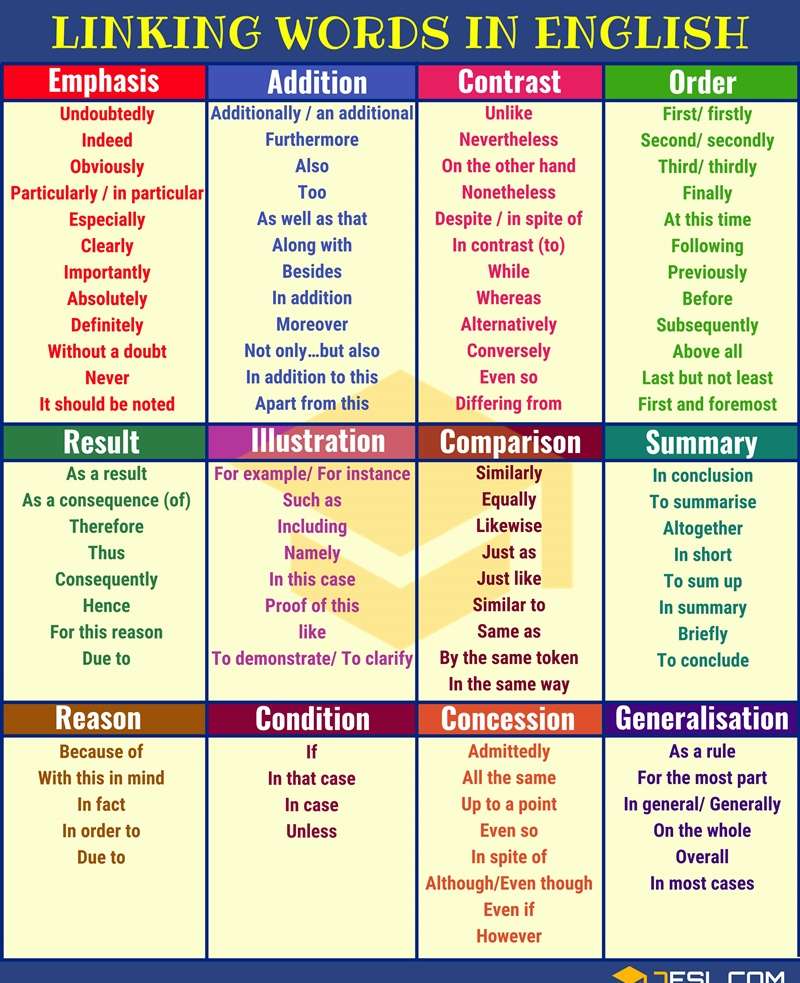Transition (linguistics)
A transition is a word or phrase that shows the relationship between paragraphs or sections of a text or speech.[1] Transitions provide greater cohesion by making it more explicit or signaling how ideas relate to one another.[1] Transitions are "bridges" that "carry a reader from section to section."[1] Transitions guide a reader through steps of logic, increments of time, or through physical space. Transitions "...connect words and ideas so that your readers don't have to do the mental work for you."[2]
Definition
In simple terms, a transition word demonstrates the relationship between two portions of the text or spoken language. By using the imagery of a bridge, we can see how these words take us from one statement to another. By using these words we can better build a sentence and convey what we are trying to say in a more concise manner. [3]

There is more than one type of transition word and in this section, we are going to introduce you to some of the most commonly used ones, which will give you a greater understanding of the concept.
Coordinating transitions
Elements in a coordinate relationship are equal in rank, quality, or significance.[4] To show a link between equal elements, use a coordinating transition.[5]
- To show similarity or reinforce: and, also, too, similarly, equally, identically, equally important, together with, not only ... but also, coupled with, in the light of, not to mention, as well as, furthermore, moreover, in the same fashion/ way, likewise, comparatively, correspondingly, by the same token, uniquely, to say nothing of.
- To introduce an opposing point: but, however, yet, on the contrary, on the other hand, in contrast, still, neither, nor, nevertheless, besides[5]
- To signal a restatement:[6] that is, in other words, in simpler terms, to put it differently, indeed.
Subordinating transitions
- To introduce an item in a series:[7] first, in the first place, *second, in the second place, for one thing...., for another, next, then, in addition, finally, last,[8]
- To introduce an example:[9] in particular, specifically, for instance, for example, that is, namely
- To show causality: as a result, hence, thus, so, then, because, since, for, consequently, accordingly, therefore
- To introduce a summary or conclusion:[7] in conclusion, finally, all in all, evidently, clearly, actually, to sum up, altogether, of course
- To signal a concession:[9] naturally, of course, it is true, to be sure, granted, certainly
- To resume main argument after a concession: all the same, even though, still, nevertheless, nonetheless
Temporal transitions
- To show frequency: frequently, hourly, often, occasionally, now and then, day after day, every so often, again and again
- To show duration: during, briefly, for a long time, minute by minute, while
- To show a particular time: now, then, at that time, in those days, last Sunday, next Christmas, in 1999, at the beginning of August, at six o’clock, first thing in the morning, two months ago, when,
- To introduce a beginning: at first, in the beginning, since, before then
- To introduce a middle: in the meantime, meanwhile, as it was happening, at that moment, at the same time, simultaneously, next, then
- To signal an end (or beyond): eventually, finally, at last, in the end, later, afterward
Spatial transitions
- To show closeness: close to, near, next to, alongside, adjacent to, facing, side by side
- To show long distance: in the distance, far, beyond, away, there
- To show direction: up/down, sideways, along, across, to the right/left, in front of/behind, above/below, inside/outside: toward/away from
Transition words of agreement, addition, or similarity
The transition words like also, in addition, and, likewise, add information, reinforce ideas, and express agreement with preceding material.[10]
- in the first place
- not only … but also
- as a matter of fact
- in like manner
- in addition
- coupled with
- in the same fashion / way
- also
- then
- equally
- identically
- uniquely
- like
- as
- again
- to
- and
- too
- moreover
- as well as
- together with
- of course
- first, second, third
- in the light of
- not to mention
- to say nothing of
- equally important
- by the same token
- likewise
- comparatively
- correspondingly
- similarly
- furthermore
- additionally
- what's more
Notes
- Rappaport 2010, p. 95
- Garner 2002, p. 65
- "Transition Words and Phrases: Useful List and Examples". 7esl.com. 7ESL. Retrieved 5 Jan 2019.
- Merriam-Webster
- Lindemann 2001, p. 152
- UW Writing Center
- Purdue Online Writing Lab
- Smart Words
- Taraba
- "Transition words used in content creation - Complete GUIDE". Growwwise. 2018-12-02. Retrieved 2018-12-02.
References
- Rappaport, Bret (2010). "Using the Elements of Rhythm, Flow, and Tone to Create a More Effective and Persuasive Acoustic Experience in Legal Writing" (PDF). The Journal of the Legal Writing Institute. The Legal Writing Institute. 16 (1): 65–116. Retrieved 30 March 2013.
- Garner, Bryan A. (2002). The Elements of Legal Style (2nd ed.). Oxford University Press. p. 65. ISBN 0195141628.
- "Coordinate". Merriam Webster. Archived from the original on 30 March 2013. Retrieved 30 March 2013.
- Erika Lindemann (2001). A Rhetoric for Writing Teachers (4th ed.). New York: Oxford University Press. p. 146. ISBN 0-19-513045-6.
- Ryan Weber, Karl Stolley. "Transitions and Transitional Devices". Purdue Online Writing Lab (OWL). West Lafayette, Indiana: Purdue University. Retrieved 30 March 2013.
- Taraba, Joanna. "Transitional Words and Phrases". University of Richmond Writing Center. Richmond, Virginia: University of Richmond. Archived from the original on 30 March 2013. Retrieved 30 March 2013.
- "Transition Words". Smart Words. Archived from the original on 29 March 2013. Retrieved 29 March 2013.
- "The Writer's Handbook: Transitional Words and Phrases". University of Wisconsin Writing Center. Madison, Wisconsin: University of Wisconsin-Madison. 2012. Archived from the original on 30 March 2013. Retrieved 30 March 2013.